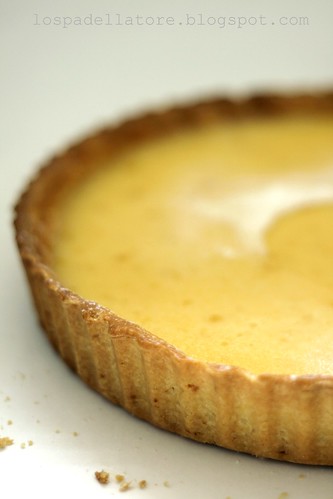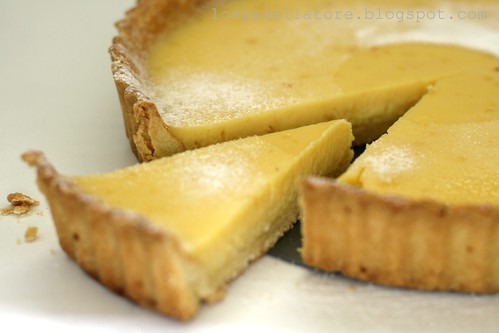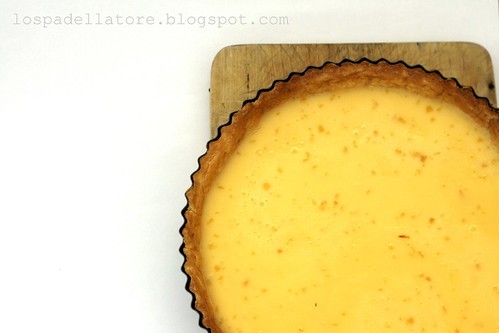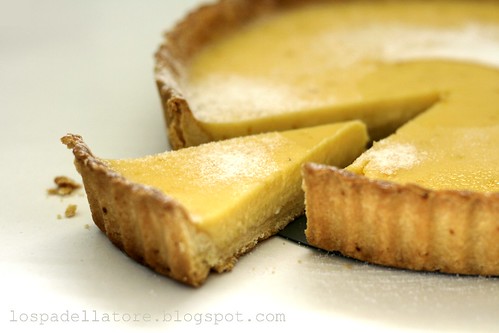La foto
La storiella
Un paio di settimane fa ho mi sono iscritto alla biblioteca vicino al mio ufficio. Quindi ho iniziato a dare un'occhiata ai libri disponibili. Ovviamente nella sezione culinaria. :D
Cercavo alcuni libri scritti dai miei cuochi preferiti come Ad hoc at home di Mr. Thomas Keller e The fat duck cookbook del prof. Heston. :)
Purtroppo erano in prestito. Così ho iniziato a leggere l'introduzione del The Gavroche cookbook di Michel Roux Jr, interessante e stimolante. Mmm cucina francese, non la conosco molto... così ho iniziato a sfogliare French Lessons di Justin North: un sacco di ricette di base tradizionali che non ho ancora fatto! Crème caramel, creme brulee, lemon tart... Così la settimana scorsa ho preso in prestito un altro libro di Raymond Blanc (Raimondo Bianco? :D) e ho fatto la sua lemon tart.
Comunque sono stato ispirato a farla dopo aver visto quella di Heston. Che figata. :)
La ricetta è qui (in inglese)
Ingredienti Mise en place per una tortiera di 24 cm di diametro
- burro a temperatura ambiente a cubetti: 120 g
- zucchero a velo: 75 g
- tuorli d'uovo: 2 + 1 (60 g)
- farina: 250 g
- uova: 5 (250 g)
- zucchero: 150 g
- succo di limone: 85 g
- buccia di limone: 2 cucchiai (15 g)
- panna: 150 g
Preparazione
- in una ciotola, lavorare il burro e lo zucchero a velo fino ad ottenere una crema
- incorporare 2 tuorli
- aggiungere la farina, lavorare con la punta delle dita fino ad ottenere un insieme di briciole (io ho usato un coltello e ho simulato l'impastatrice :D)
- formare una palla
- impastare per massimo 30 secondi su un piano leggermente infarinato
- avvolgere nella pellicola, frigo 30 minuti (siccome faccio disastri quando stendo la pasta frolla l'ho stesa direttamente nella tortiera schiacciandola con le dita, poi ho messo in frigo)
- stendere la pasta e ricoprire la tortiera
- fare dei buchi con la forchetta (altrimenti lievita), coprire con la carta forno o foglio di alluminio, riempire con riso o fagioli o quello che volete ed infornare per 10 minuti
- rimuovere dal forno, togliere il "peso", spennellare con il rimanente tuorlo ed infornare per altri 20 minuti
- per la crema: mescolare tutti gli ingredienti e riscaldare con un pentolino o a bagnomaria (60 gradi io)
- versare la crema sulla pasta frolla, altri 25 minuti in forno fino a quando la crema raggiunge i 70 gradi (Heston docet)
- fatta.
Dati nutrizionali
| Calorie per 100 g | 384 kcal |
| Carboidrati | 44% |
| Proteine | 8% |
| Grassi | 48% |
L'angolo della cultura
La cottura in bianco è quando si cuoce la pasta frolla prima di riempirla con la crema. Di solito si buca la pasta in modo tale che non cresca e lieviti durante la cottura. Una volta stesa nella tortiera si copre la pasta frolla con un foglio di alluminio o carta forno e si riempie con dei pesi come riso, fagioli (crudi! :)) o monete (trasmettono meglio il calore dice prof Heston :)) e si inforna. Dopo la prima fase (dipende dalla ricetta) si rimuovono i "pesi" e la carta e si inforna per la seconda volta, in modo tale da creare una bella crosta dorata.
Tutto questo perché se il ripieno è troppo liquido e si cuoce la pasta frolla "cruda" si rischia che resti molliccia e non cuocia perfettamente.
ShareThe photo
The little history
A couple of weeks ago I subscribed to the library close to my office. Then, I take a look at the books available. Obviously in the cooking section. :D I was looking for some books written by my favourite chefs like Mr. Thomas Keller's Ad hoc at home and prof. Heston's The fat duck cookbook. :)
Unfortunately they were on loan. So I started reading the introduction of The Gavroche cookbook by Michel Roux Jr, interesting and inspirational. Mmm French cooking, I don't know much about it... so I started to flick through another one French Lessons by Justin North. Wow, so many traditional recipes that I haven't already cooked: creme caramel, creme brulee, lemon tart... So last week I borrowed another book by Raymond Blanc and I baked his lemon tart.
Anyway I was inpired to make it after I have seen Heston's. Very cool. :)
The recipe is here
Ingredients Mise en place for a 24 cm round tart tin
- unsalted butter at room temperature, diced: 120 g
- icing sugar: 75 g
- egg yolks: 3
- flour: 250 g
- eggs: 5 (250 g)
- sugar: 150 g
- lemon juice: 85 g
- lemon zest: 2 tbs (15 g)
- cream: 150 g
Method
- in a large bowl with a spatula or wooden spoon cream butter and sugar
- beat in 2 of egg yolks
- add flour, with fingertips rub butter mixture to form breadcrumbs
- add water, form a ball
- knead pastry in a floured surface for 30 seconds, not overwork
- refrigerate 30 minutes
- roll pastry and line the tin
- blind bake (see here) 10 minutes
- remove weights from the shell, brush with remained egg yolk, bake for 20 minutes
- mix together ingredients, warm gently in a saucepan
- fill the shell and bake for 25 minutes
- done.
Nutritional facts
| Calories 100 g | 384 kcal |
| Carbohydrates | 44% |
| Proteins | 8% |
| Fat | 48% |
The culture corner
Blind baking is when the pastry is cooked before fill it with the filling. Usually after rolling and line the cake tin the bottom is priked with a fork in order to prevent the pastry to rise. Then the pastry is covered with aluminium foil or graseproof paper. Then the shell is filled with some weights always in order to prevent the pastry to rise, usually raw beans, rice or coins (these transmit better the heat). After the amount of time indicated in the recipe (it depends on the amount of pastry, the dimension of the cake tin etc.) the "weight" is removed and the pastry is baked again so a nice gold crust will form.
This process is necessary for some recipes because if the filling is too liquid and the pastry is cooked raw it will be soggy and not completely cooked.
Share




Bona! Ma sei sicuro di quella storia delle monete? Mi da l'idea che non siano gli oggetti più puliti che puoi trovare in giro... va ben che cota xè bona anca la merda, però.... ;)
RispondiEliminaCerto, guarda Heston qui! Comunque si mette la carta tra la frolla e le monete... ;)
Elimina